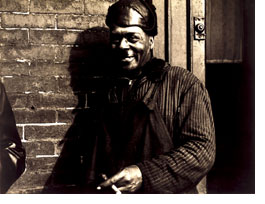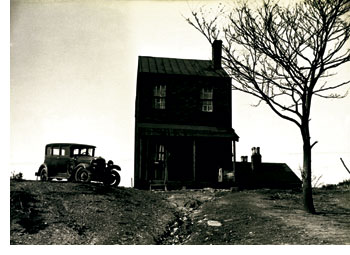Back
IN
PRAISE OF LUKE
SWANK
By
Christine H. O’Toole
Swank’s premature death in 1944
at the age of 54 cut short a career that had already
been limited by a late start. “He was a real
giant of photography who fell through the cracks
of history,” says Howard Bossen, curator of
Luke Swank: Modernist Photographer, now at Carnegie
Museum of Art.
 Left: Man
with Cigar, c. 1939, Property of the Western Pennsylvania
Consevancy Left: Man
with Cigar, c. 1939, Property of the Western Pennsylvania
Consevancy
To Bossen, a professor of journalism
at Michigan State University who discovered Swank’s
work while at Carnegie Mellon University as Distinguished
Visiting Professor in the Center for the Arts in
Society for 2001-2002, Swank was a photographer who
precisely and poetically documented his world. “You
see that in some of the people images in steel mills,” he
notes, “or in the backyard images of the circus—the
clown reading his newspaper, or a man resting on
a stack of hay bales with a dog on the ground below.
These little moments of life carry through into his
urban work.”
“
Swank was admired by his contemporaries, but he is
under appreciated by specialists,” says Louise
Lippincott, Carnegie Museum of Art curator of fine
arts. “It’s our job to put him back where
he belongs.” The Subject is Pittsburgh
Luke Swank: Modernist Photographer highlights
one of Carnegie Museum of Art’s strengths:
its deep collection of photographic work relating
to Pittsburgh and Pittsburghers.
“
We’ve made Pittsburgh photography a mission,” says
Lippincott, recounting a number of the museum’s popular
photography exhibitions such as the 1997 Pittsburgh Revealed,
which featured images by Swank, and the 2001 Eugene Smith
showcase, Dream Street. The museum owns hundreds of images
taken by Swank
from the mid-1920s to the early 1940s, and in 2001, it acquired
the massive archive of Pittsburgh photographer Teenie Harris,
containing more than 80,000 negatives. Last year, the museum
announced its acquisition of the archives of McKeesport native
Duane Michals. (Showing concurrently with the Luke Swank
exhibition is Witness to the Fifties: Selections from
the Pittsburgh Photographic
Library, which documents the city’s postwar renaissance
and showcases photographs from the collections of Carnegie
Museum of Art and University of Pittsburgh Press. See
below.)
Originally from Johnstown, Pennsylvania, Swank shot the
familiar: steel mills and street scenes. By 1930, he had
opened his own
studio and was beginning to take on commercial work. Adept
at transforming industrial parts and mundane household
items into interesting abstract forms and creating vivid portraits,
Swank received assignments from some of the most prestigious
magazines of the day, such as Fortune and Life. Says Pittsburgh
photographer Clyde Hare, who curated the Museum of Art’s
1980 show of Swank’s work, “When
I came to Pittsburgh in 1950, I was told that for visual
representation, I should study (painter) John Kane and Luke
Swank.”
Swank also documented the vanishing tradition
of traveling circuses, capturing roustabouts, clowns, and
performers
offstage in haunting images. Both the industrial material
and the
circus “were,
initially, easy local subjects,” says guest curator
Bossen. “Johnstown
was his home—he was surrounded by steel in those
days. And the circus was an important subject to Luke Swank.” (Swank’s
son, Harry, inherited the family obsession, eventually
becoming part owner of a circus.)
Enlightened Amateur
Born in 1890 to a wealthy family, Swank became serious about
photography after attending the Pennsylvania Agricultural
College (now Penn State University) and serving in World
War I. After the war, he and his first wife, Grace, along
with son Harry, returned home to Johnstown, where he entered
the family business as manager of a hardware store and later
became manager of the family automobile dealership. In 1931,
at the age of 41, he was still selling cars in Johnstown
when he started exhibiting photographs.
“
He started as an enlightened amateur,” says Bossen.
And the enlightened layman quickly became a luminary.
Swank
wrote in December 1931 to a young Julien Levy, who
had just opened a gallery in New York City and championed
modernist photography at a time when few were doing this. With
Levy’s help,
Swank began showing his work in prestigious photography
exhibitions.
 Car,
House, and Tree, , Carnegie Museum of Art, Gift of Edith
Swank Long Car,
House, and Tree, , Carnegie Museum of Art, Gift of Edith
Swank Long
In March 1932, Swank’s work was included
with that of Berenice Abbott, Margaret Bourke-White, Imogen
Cunningham,
Walker Evans, Man Ray, and Edward Steichen in International
Photographers at the Brooklyn Museum of Art. Later
that year, Swank contributed to the New York
Museum of Modern Art’s first show to combine painting
and photography—along with Georgia O’Keeffe
and Ben Shahn. And in 1934, he placed more work than
any other artist in San Francisco’s First Salon
of Pure Photography, where Willard Van Dyke, Edward
Weston, and Ansel Adams
selected photography for the show. By 1935, the effects
of the Great Depression on the Swank family businesses
prompted Swank to make his passion his profession and move
his family to Pittsburgh, where he became the University of
Pittsburgh’s first official
photographer, also creating and teaching one of the first
college-level courses in photojournalism. Two years later,
he left the university
to open his own studio, picking up such clients as Aluminum
Company of America, Calgon, Chevrolet, and General Electric.
Swank’s work with his most important commercial client,
H. J. Heinz Company, introduced him to his second wife,
Edith, a writer for the company. The two married after the
death of
Grace, and Edith served as his collaborator and business
partner. Rediscovering Swank
While Swank’s work was widely praised, exhibited, and
published during his brief career, dealers like Levy found
it hard to establish a market for photographic prints. Bossen’s
research uncovered 1930’s price lists from Levy’s
New York gallery: a Walker Evans photo priced at $15, a Swank
photo at $7.50, and an original 19th-century Mathew Brady photo
at $1.
Swank’s commercial work sustained him financially.
But after nearly 10 years in Pittsburgh, dividing time between
commercial assignments and his own prolific work, Swank died
of a heart attack in 1944.
“
He died too young,” Lippincott says, “just
as his reputation was being established.”
“
Swank died before there was an art market in photography,
and with no images in circulation, it was hard to keep
a reputation going,” Bossen notes. “His wife
tried to be a good steward of her husband’s work,
but was uncertain how best to do this. Due to a variety
of circumstances, she was unable
to place his work in a museum. She held onto it, bequeathing
his
photographic archive to the Carnegie Library after her
death in 1974.”
Edith
Swank had worked for the H. J. Heinz Company for several
decades and maintained a cordial relationship with H. J. “Jack” Heinz.
When the executor of her will contacted Heinz to offer
Luke Swank’s collected
works to the public library, he agreed to oversee the transfer.
Today, the Swank collection is shared by Carnegie Museum
of Art, with 366 photographs, and Carnegie Library of Pittsburgh,
with about 4,000 negatives, 2,400 prints, and most of his
color transparencies.
Curator Bossen hopes that Luke Swank: Modernist Photographer,
first shown at the Kresge Art Museum in East Lansing, Michigan,
will help people rediscover Swank’s
work.
Photographer Charlee Brodsky of Carnegie Mellon University
agrees. In a comment she wrote for the show’s catalogue,
she notes, “An important photographer
is rediscovered, not only for western Pennsylvania but
for the history
of photography in our country.”
Back | Top
| WITNESS
to the Fifties "If
Luke Swank photographed places and ways of life that
were disappearing, the Pittsburgh Photographic Library
(PPL) documented what was replacing them. The juxtaposition
of the two shows is very poignant,” explains
Curator Louise Lippincott of Witness to the Fifties:
Selections from the Pittsburgh Photographic Library,
1950-53. The exhibition runs concurrently
with the Swank exhibition in Carnegie Museum of Art’s
Works on Paper gallery.
The
Pittsburgh Photographic Library was a typically
audacious project
of the
Allegheny Conference on Community
Development, whose leaders sought an artistic and
journalistic record of the city’s first renaissance.
Two members—Wallace
Richards, the Conference’s secretary and then-director
of Carnegie Museum of Art, and Phillip Broughton,
secretary of the A.W. Mellon Trust—launched
the idea of hiring the nation’s top photographers
to create an archive. They would work under the direction
of
the legendary Roy Stryker, who had directed similar
projects for the U.S. Farm Security Administration
and Standard Oil. Over three years, the group shot
some 23,000 images; the exhibition includes 80.
Stryker
defined the PPL’s mission broadly, to
include photo essays on families, street scenes,
hospitals, celebrations, as well as demolition and
construction.
His influence on his eager staff was immense.
Recalls
local photography legend Clyde Hare, 78, who was
one of the project’s youngest staffers, “He
was one of the most dynamic men I’ve ever known
in my life. He knew every photo editor in the country.
He’d debrief every photographer, before and
after a shoot. If you were going to shoot a bridge,
he’d
send you with a two- or three-page outline. He’d
want to know: Do people live there? Fish there? Does
the river level change? You’d start thinking
about it in a way you hadn’t before. It became
a challenge to surprise him.”
The
project produced the desired bank of Pittsburgh
images for
national
publications and for a popular
1951 exhibition at Carnegie Museum of Art. People
in Pictures, sponsored by the city’s Community
Chest agency (a precursor of the United Way), documented
the varied work of local social service agencies.
Renowned
photographers Sol Libson and Esther Bubley, who shot
many of the exhibited images, were later joined by
Russell Lee, Harold Corsini, and other famous—and
well-paid—photographers.
Richard
Saunders, a Bermudan, documented the Hill District
prior to
much of its demolition to make
way for the
construction of the Civic Arena (now Mellon Arena).
Younger photographers like Hare gained the experience
of working alongside these masters, and enjoyed some
attention of their own. In 1951, Life magazine’s
prestigious contest for young photographers (of which
Stryker was a judge) awarded prizes to Saunders,
Regina Fisher, and Hare for work created through
the PPL.
As initial funding ran dry, arguments on
how the PPL would continue its work slowed its momentum.
Stryker
resigned in 1951. In 1959, five years after the project
officially concluded, he intervened to preserve the
negatives and images, which were transferred to the
Pennsylvania Division of Carnegie Library.
“
In creating the exhibition, we tried to combine familiar,
much-loved views with a few surprises,” says
Lippincott. (The book Witness to the Fifties, published
in 1999 by the University of Pittsburgh Press, serves
as the exhibition’s catalog.) “Stryker
encouraged photographers to look in all kinds of
places. Documenting the way the city was growing
and changing
frequently involved scenes showing people. These
are very human landscapes. I think you realize from
them
how much the region changed between 1935 and 1950.” |
Back | Top
|